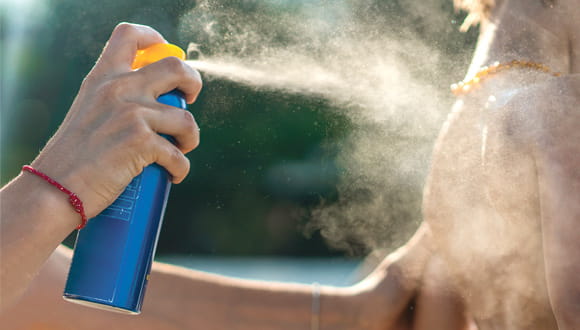When something seems too convenient, you can start to get suspicious about how well it actually works.
So, let's talk about spray sunscreen — arguably the easiest way to apply sunscreen, especially when it comes to a hard-to-reach area like your back.
It's no surprise that many of us prefer it over the alternatives. But is spray sunscreen actually as effective?
Which is better: Spray sunscreen or lotion?
We wear sunscreen to help prevent skin cancer, so of course it's important for us to feel confident that our preferred sunscreen choice actually works.
To be effective, a sunscreen must be:
- Broad spectrum
- SPF 35 or higher for everyday use
- Water-resistant if you're going to be swimming or sweating
Be sure to check for this information when choosing a sunscreen.
The good news is that — if these criteria are met and the correct amount is used —experts say that the "best sunscreen" is whichever one you'll actually wear. Additionally, the FDA considers spray sunscreen to be generally recognized as safe and effective.
(Related: Does Sunscreen Expire?)
But, in terms of how much sunscreen is enough, sprays can be harder to quantify than the non-spray alternatives.
How much spray sunscreen should you use?
We've all heard the sunscreen advice: Slather yourself with plenty of it.
For effective protection from the sun, it takes about an ounce of it to cover the average adult body. (That's basically a handful of lotion, or about enough to fill a shot glass, by the way.)
But what about when your sunscreen is meant to be sprayed, not slathered? The answer: Spray generously.
Given this, it can be tricky to know whether you're actually applying enough spray sunscreen to fully protect your skin. But it's not impossible.
5 tips for applying spray sunscreen effectively and safely
1. Spray until your skin glistens
It's hard to speak in amounts when it comes to a product you spray, but it still takes about an ounce of spray sunscreen to fully cover and protect your sun-exposed skin.
Since you'll likely need a visual of what makes an ounce, the American Academy of Dermatology recommends spraying all exposed areas until your skin glistens. Or, you can spray each area of your body for six seconds.
One last "how much spray is enough spray" rule of thumb: A standard six-ounce can of spray sunscreen should only last you six applications total. If you're using your sunscreen beyond this, it could be a sign that you haven't been applying enough.
2. Rub it in after you spray
It's called spray sunscreen, but, to be truly effective, it takes more than just spraying.
To get an even, consistent layer across all of your skin, experts recommend rubbing spray sunscreen in after you spray it on.
3. Don't spray directly on your face and avoid inhaling spray sunscreen
The ingredients in spray sunscreens are safe for your skin, but they can be irritating to the lungs if inhaled.
Importantly, this means that you should never spray sunscreen directly on your face. Instead, spray it into your hands and rub it onto your face, taking care to avoid your eyes and mouth.
You'll also want to be cautious about inadvertent inhalation of spray sunscreen if it's a windy day or if you're spraying it on a squirming child.
4. Consider using lotion as your base and reapplying with a spray
If you're still struggling with your spray sunscreen — unsure whether you're applying enough — you might consider using a lotion first and switching to a spray when it's time to reapply your sunscreen.
5. Reapply until you're glistening and according to the label's instructions
Even when reapplying sunscreen, be sure to spray generously until your skin is glistening and rub the sunscreen in to ensure complete coverage.
In general, it's best to reapply sunscreen every two hours — but be sure to check the label's specific instructions regarding when to reapply the particular sunscreen you're using.
And while a sunscreen labeled "Sport" might be water-resistant, keep in mind that these aren't towel-resistant. If you towel off after being in the water or sweating, it's time to reapply.
Lastly, properly using spray sunscreen isn't the only recommended step for protecting your skin from the sun. It's also important to seek shade and wear protective clothing, such as a wide-brimmed hat, sunglasses with UV protection and a long-sleeved shirt and pants, if possible.
Need care now?
Houston Methodist Virtual Urgent Care offers on-demand video visits from wherever you are, no appointment needed. Our board-certified providers are available 24/7 to address many common health issues.








